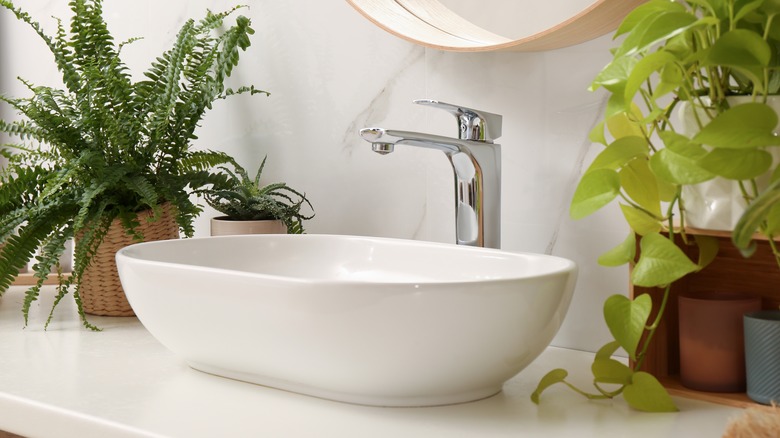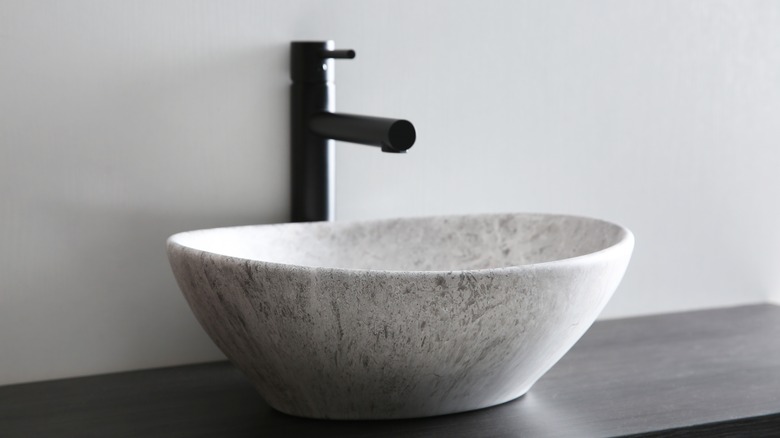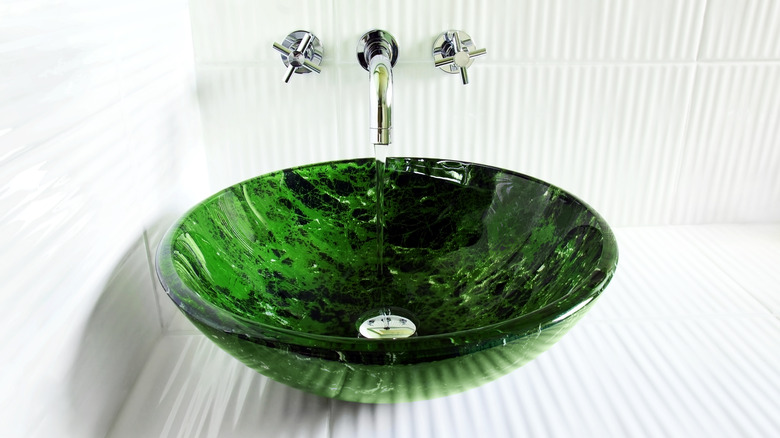Here's Why Installing A Vessel Sink Might Require New Countertops
When it comes to creating a sleek, modern aesthetic in your bathroom, it's hard to compete with a vessel sink. Whether you opt for a classic white porcelain style or something design-led made of natural stone or clear glass, their above-counter position makes them catch the eye of anyone who sets foot in the bathroom. Sinks are an essential bathroom fixture, but vessel sinks provide a statement at the same time. However, one thing that must be considered before deciding if a vessel sink is right for your bathroom is your existing countertops.
While it's easy to fall in love with a particular sink and call it a day, this can lead to disappointment and money lost. Choosing the right sink that will amp up your home mostly comes down to the current holes in your countertops — if they were built for another type of sink, they likely won't be able to accommodate this unique layout and will need to be fully replaced. If you must go with new countertops, consider that your vessel sink will be placed on top of it rather than halfway or fully inlaid within the surface. Vessel sinks may be cool, but old countertops can be prohibitive if you're not willing to replace them. Here's what to consider prior to purchasing or installing a vessel sink and if it'll work with the features already existing in your room.
The countertop hole may be too big for a vessel sink
The biggest issue that arises with vessel sinks and countertops is the fit, especially if another style of sink was used previously. Inset, semi-inset, and built-in sinks are all types that have some portion (or all) of their basin built into the counter. This requires a sizable hole cut into the countertop in order for them to neatly slide in—a hole that's usually much larger than the bottom of a vessel sink. A vessel sink sits above countertops, so if the previously cut hole swallows it whole (or nearly does so), you'll likely have to replace the surface.
The holes required for vessel sinks are usually only as big as the drain and mouth of the pipe that carries water away. These are relatively small and, of course, no bigger than the base of the sink. In some instances, if the hole is larger than the drain components, it should fare okay as long as everything is sealed tightly. If the base can cover up the rest of the empty space, only you will know it's there, and a countertop replacement may not be a must-do. If it can be seen, it'll be nearly impossible to fully patch up and it can cause trouble for the basin's stability.
The drainage and faucet control holes may be in the wrong place
Another issue that pops up with the installation of vessel sinks on old countertops is leftover drainage and faucet holes. For the former, a drainage hole could be in the wrong place, or if you're moving from a semi-recessed vessel sink to a true vessel sink, the problem of too large a hole can reappear. For sinks with an off-set sink drain, a centered hole won't be of much use, and vice versa. If the sink hole is slightly too large, this can be remedied with sealing rings and mounting rings to get the perfect fit.
As for faucet control holes? These may be in the wrong spaces, too. If you're using the same style of faucet control as your former sink, such as a single lever or two turnable controls, the transition should be relatively seamless, but if you're switching from a single lever to two handles or a counter-mounted faucet to a wall-mounted design, installation becomes trickier, and gaping holes may be leftover. Sometimes, these can be fixed with sink hole covers, but these can be distracting if you can't find a color or finish that matches the sink or its faucet color. Vessel sinks aren't the only types to cause problems (there are plenty of installation mistakes with buying a pedestal sink or inset sink, too), but knowing their differences from other styles of sinks will prevent money and time from going down the drain.


